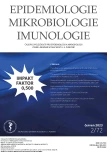A word on the microbiome: considerations about the history, current state, and terminology of an emerging discipline
Authors:
V. Černý 1; J. Hrdý 1; J. Beneš 2; H. Tláskalová 1,3
Authors‘ workplace:
Ústav imunologie a mikrobiologie, 1. lékařská fakulta Univerzity Karlovy a Všeobecná fakultní nemocnice v Praze, Praha
1; Klinika infekčních nemocí, Fakultní nemocnice Bulovka a 3. lékařská fakulta Univerzity Karlovy, Praha
2; Mikrobiologický ústav AV ČR, v. v. i., Praha
3
Published in:
Epidemiol. Mikrobiol. Imunol. 72, 2023, č. 2, s. 112-118
Category:
Review Article
Overview
Since the beginning of the 21st century, a new discipline, microbiome science, has emerged as a key part of microbiology and related biomedical and ecological sciences. Microbiome science uses highly advanced molecular genetic and bioinformatic methods to study complex microbial communities. Unlike isolated microbes, microbial communities shaped by the environment, referred to as microbial consortia or microbiomes, follow their own laws that allow for significant functional specialization. The synthesis of multimethodology and multidisciplinary data enables microbiome science to move towards a holistic picture of the microbiome in an exceptionally effective way, but on the other hand, it burdens the field with terminological ambiguity of the key terms, which consequently need to be clearly codified in accordance with the international trends in the use of technical nomenclature. To this end, we present in our article the official position of the Czech Microbiome Society of the J. E. Purkyně Czech Medical Society on the use of appropriate Czech terms in both professional and general communication.
Sources
1. Charlton SGV, White MA, Jana S, et al. Regulating, Measuring, and Modeling the Viscoelasticity of Bacterial Biofilms. J. Bacteriol,, 2019;201(18):e00101–19.
2. Motta JP, Wallace JL, Buret AG, et al. Gastrointestinal biofilms in health and disease. Nat. Rev. Gastroenterol. Hepatol., 2021;18(5):314–334.
3. Høiby N. A personal history of research on microbial biofilms and biofilm infections. Pathog. Dis., 2014;70(3):205–211.
4. Tlaskalová-Hogenová H, Štěpánková R, Kozáková H, et al. The role of gut microbiota (commensal bacteria) and the mucosal barrier in the pathogenesis of inflammatory and autoimmune diseases and cancer: contribution of germ-free and gnotobiotic animal models of human diseases. Cell Mol. Immunol., 2011;8(2):110–120.
5. Manos J. The human microbiome in disease and pathology. APMIS Acta Pathol. Microbiol. Immunol. Scand, 2022.
6. Bozzetti V, Senger S. Organoid technologies for the study of intestinal microbiota–host interactions. Trends Mol. Med., 2022;28(4):290–303.
7. Janečková L, Kostovčíková K, Švec J, et al. Unique Gene Expression Signatures in the Intestinal Mucosa and Organoids Derived from Germ-Free and Monoassociated Mice. Int. J. Mol. Sci., 2019;20(7):1581.
8. Zhang J, Huang YJ, Yoon JY, et al. Primary Human Colonic Mucosal Barrier Crosstalk with Super Oxygen-Sensitive Faecalibacterium prausnitzii in Continuous Culture. Med., 2021;2(1):74–98.e9.
9. Freire R, Ingano L, Serena G, et al. Human gut derived-organoids provide model to study gluten response and effects of microbiota-derived molecules in celiac disease. Sci. Rep., 2019;9(1):7029.
10. Kim HJ, Huh D, Hamilton G, et al. Human gut-on-a-chip inhabited by microbial flora that experiences intestinal peristalsis-like motions and flow. Lab. Chip., 2012;12(12):2165–2174.
11. Wu Q, Liu J, Wang X, et al. Organ-on-a-chip: recent breakthroughs and future prospects. Biomed. Eng. Online, 2020;19(1):9.
12. Falk PG, Hooper LV, Midtvedt T, et al. Creating and maintaining the gastrointestinal ecosystem: What we know and need to know from gnotobiology. Microbiol. Mol. Biol. Rev., 1998;62(4):1157–1170.
13. Šterzl J, Říha I. Developmental aspects of antibody formation and structure. Praha: Academia;1970. 474 s.
14. Schwarzer M, Repa A, Daniel C, et al. Neonatal colonization of mice with Lactobacillus plantarum producing the aeroallergen Bet v 1 biases towards Th1 and T-regulatory responses upon systemic sensitization. Allergy, 2011;66(3):368–375.
15. Schwarzer M, Makki K, Storelli G, et al. Lactobacillus plantarum strain maintains growth of infant mice during chronic undernutrition. Science, 2016;351(6275):854–857.
16. Štěpánková R, Powrie F, Kofroňová O, et al. Segmented filamentous bacteria in a defined bacterial cocktail induce intestinal inflammation in SCID mice reconstituted with CD45RBhigh CD4+T cells. Inflamm. Bowel Dis., 2007;13(10):1202–1211.
17. Tlaskalová-Hogenová H, Vannucci L, Klimešová K, et al. Microbiome and colorectal carcinoma: insights from germ-free and conventional animal models. Cancer J. Sudbury Mass, 2014;20(3):217–224.
18. Šplíchal I, Rychlík I, Gregorová D, et al. Susceptibility of germ-free pigs to challenge with protease mutants of Salmonella enterica serovar Typhimurium. Immunobiology, 2007;212(7):577–582.
19. Kverka M, Tlaskalová-Hogenová H. Two faces of microbiota in inflammatory and autoimmune diseases: triggers and drugs. APMIS, 2013;121(5):403–421.
20. Whipps JM, Lewis K, Cooke RC. Mycoparasitism and plant disease control. In: Burge MN. Fungi in biological control systems. Manchester: Manchester University Press;1988. p. 161–187.
21. Hooper LV, Gordon JI. Commensal Host-Bacterial Relationships in the Gut. Science, 2001;292(5519):1115–1118.
22. Berg G, Rybakova D, Fischer D, et al. Microbiome definition re-visited: old concepts and new challenges. Microbiome, 2020;8(1):103.
23. Marchesi JR, Ravel, J. The vocabulary of microbiome research: a proposal. Microbiome, 2018;3(1):31, s40168-015-0094–0095.
24. Virgin HW. The Virome in Mammalian Physiology and Disease. Cell, 2014;157(1):142–150.
25. Handelsman J, Rondon MR, Brady SF, et al. Molecular biological access to the chemistry of unknown soil microbes: a new frontier for natural products. Chem. Biol., 1998;5(10):R245–R249.
Labels
Hygiene and epidemiology Medical virology Clinical microbiologyArticle was published in
Epidemiology, Microbiology, Immunology

2023 Issue 2
Most read in this issue
- Selected aspects of mortality in Czechia and Slovakia in the pandemic year 2020
- A word on the microbiome: considerations about the history, current state, and terminology of an emerging discipline
- The influence of meteorological factors on the risk of tick-borne encephalitis infection
- Secondary prevention of lung cancer in the Czech Republic – pitfalls, risks, benefits
